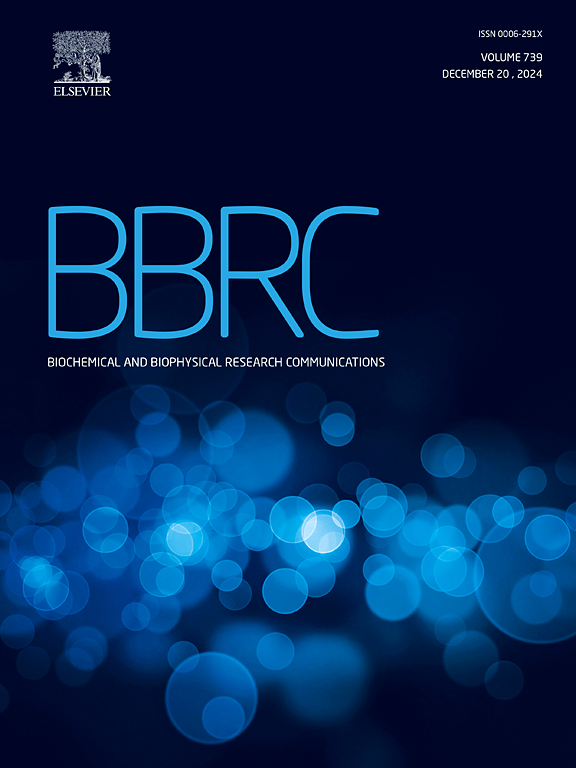热量限制会改变 NCOA2 的剪接,从而调节皮下白色脂肪组织的脂质代谢
IF 2.2
3区 生物学
Q3 BIOCHEMISTRY & MOLECULAR BIOLOGY
Biochemical and biophysical research communications
Pub Date : 2025-04-22
DOI:10.1016/j.bbrc.2025.151871
引用次数: 0
摘要
热量限制(CR)通过调节基因表达和细胞过程来促进长寿和代谢健康。然而,替代 mRNA 剪接在 CR 诱导的代谢适应中的作用仍未得到充分探索。在这项研究中,我们分析了 CR 小鼠皮下白色脂肪组织的 RNA 测序数据。我们发现了 6058 个差异表达基因,其中 Elovl6、Fasn 和 Srebp1c 等脂质代谢通路基因显著上调。我们还检测到 400 个与 CR 相关的替代剪接事件,其中跳过外显子和保留内含子的事件主要影响脂质生物合成和能量代谢。在这些事件中,参与脂质代谢的核受体辅激活子 Ncoa2 在 CR 条件下表现出外显子 13 含量增加,有利于全长异构体的表达。功能测定显示,全长 NCOA2 增强了 PPARγ 介导的转录激活,而截短的Δ-NCOA2 异构体则表现出改变的辅激活剂活性。研究发现,Δ-NCOA2 缺乏对核受体相互作用至关重要的 LXXL 基序,这可能会改变其功能。综上所述,这些研究结果表明,CR 诱导的替代剪接可微调代谢和转录网络,从而促进脂质平衡和能量适应。我们的研究强调了 CR 通过协调转录和剪接改变来调节新陈代谢的一个新的调控层,为了解 CR 对衰老和新陈代谢健康产生有益影响的分子机制提供了新的视角。为了确定 CR 诱导的剪接变化的组织特异性及其对代谢紊乱和寿命延长的潜在影响,还需要进一步的研究。本文章由计算机程序翻译,如有差异,请以英文原文为准。
Caloric restriction alters NCOA2 splicing to regulate lipid metabolism in subcutaneous white adipose tissue
Caloric restriction (CR) promotes longevity and metabolic health by modulating gene expression and cellular processes. However, the role of alternative mRNA splicing in CR-induced metabolic adaptation remains underexplored. In this study, we analyzed RNA sequencing data from the subcutaneous white adipose tissue of CR mice. We identified 6058 differentially expressed genes, with significant upregulation of lipid metabolism pathway genes, such as Elovl6, Fasn, and Srebp1c. We also detected 400 CR-associated alternative splicing events, with the skipped exon and retained intron events predominantly affecting lipid biosynthesis and energy metabolism. Among these events, Ncoa2, a nuclear receptor coactivator involved in lipid metabolism, exhibited increased exon 13 inclusion under CR, favoring the expression of the full-length isoform. Functional assays revealed that full-length NCOA2 enhanced PPARγ-mediated transcriptional activation, while the truncated Δ-NCOA2 isoform exhibited altered coactivator activity. Δ-NCOA2 was found to lack an LXXL motif critical for nuclear receptor interactions, potentially modifying its function. Taken together, these findings indicate that CR-induced alternative splicing fine-tunes metabolic and transcriptional networks, thereby contributing to lipid homeostasis and energy adaptation. Our study highlights a novel regulatory layer by which CR modulates metabolism through coordinated transcriptional and splicing alterations, offering new insights into the molecular mechanisms underlying the beneficial effects of CR on aging and metabolic health. Further investigations are warranted to determine the tissue-specificity of the CR-induced splicing changes and their potential implications for metabolic disorders and lifespan extension.
求助全文
通过发布文献求助,成功后即可免费获取论文全文。
去求助
来源期刊
CiteScore
6.10
自引率
0.00%
发文量
1400
审稿时长
14 days
期刊介绍:
Biochemical and Biophysical Research Communications is the premier international journal devoted to the very rapid dissemination of timely and significant experimental results in diverse fields of biological research. The development of the "Breakthroughs and Views" section brings the minireview format to the journal, and issues often contain collections of special interest manuscripts. BBRC is published weekly (52 issues/year).Research Areas now include: Biochemistry; biophysics; cell biology; developmental biology; immunology
; molecular biology; neurobiology; plant biology and proteomics

 求助内容:
求助内容: 应助结果提醒方式:
应助结果提醒方式:


